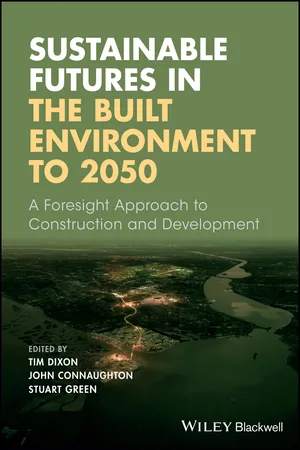
Sustainable Futures in the Built Environment to 2050
A Foresight Approach to Construction and Development
- English
- ePUB (mobile friendly)
- Available on iOS & Android
Sustainable Futures in the Built Environment to 2050
A Foresight Approach to Construction and Development
About This Book
Brings together leading thinking on issues of new professional practice and on the future of a sustainable built environment
This book focuses on both construction and development issues, and examines how we can transition to a sustainable future by the year 2050—bringing together leading research and practice at building, neighbourhood, and city levels. It deftly analyses how emerging socio-economic, technological, and environmental trends will influence the built environment of the future. The book covers a broad spectrum of interests across the scales of buildings, communities and cities, including how professional practice will need to adapt to these trends. The broader context is provided by an analysis of emergent business models and the changing requirements for expert advice from clients.
Sustainable Futures in the Built Environment to 2050: A Foresight Approach to Construction and Development features chapters covering: data and trends, including historical data and UK and international case studies; policies and practice related to the field; current state of scientific understanding; key challenges; key technological advances (including disruptive and systemic technological innovations); change issues and critical uncertainties; and future visions. It provides:
- A strong conceptual framework based on a 'Foresight' approach
- Discussion of the key data and trends that underpin each chapter
- Coverage of both construction and property development
- Specially commissioned chapters by academics and practitioners
- A synthesis of the main findings in the book and key insights for the future to 2050
Sustainable Futures in the Built Environment to 2050: A Foresight Approach to Construction and Development is an important book for postgraduate students and researchers, construction, real estate and property development specialists, engineers, planners, architects, foresight and futures studies specialists, and anyone involved in sustainable buildings.
Frequently asked questions
Information
1
Introduction: Foresight and Futures Studies in Construction and Development
‘It is far better to foresee even without certainty than not to foresee at all.’Henri Poincare, mathematician, 1854–1912 (Poincare, 1013: 129)
1.1 Background and context
- The emergence of smart construction and digital design: There is a growing convergence between different data sets and different technologies in the digital economy and through a focus on Digital Built Britain (HM Government, 2015a). For example, the growth of open data (i.e. data that can be freely used, shared and built on by anyone, anywhere, for any purpose) and big data (i.e. very large, complex and rapidly changing datasets), and the development of the Internet of Things (i.e. the network of physical objects – devices, vehicles, buildings and other items embedded with electronics, software, sensors, and networks – that enables these objects to collect and exchange data) are creating substantive opportunities for innovation. For example, the potential for embedding new technologies in buildings to create ‘intelligent assets’, where the performance of a building and its components can be constantly monitored and so create more efficient asset management and facilities management (Ellen MacArthur Foundation, 2016). Understanding asset performance will be improved therefore during both const...
Table of contents
- Cover
- Title Page
- Table of Contents
- Editorial Board
- List of Contributors
- Note on Contributors
- Foreword by Sir Terry Farrell
- Preface
- Acknowledgements
- Book Endorsements
- 1 Introduction
- Part 1: Sustainability and the Built Environment
- Part 2: Changing Professional Practice
- Part 3: Provocations about the Future
- Part 4: Transformative Technologies and Innovation
- Part 5: Conclusions and Common Themes
- Index
- End User License Agreement